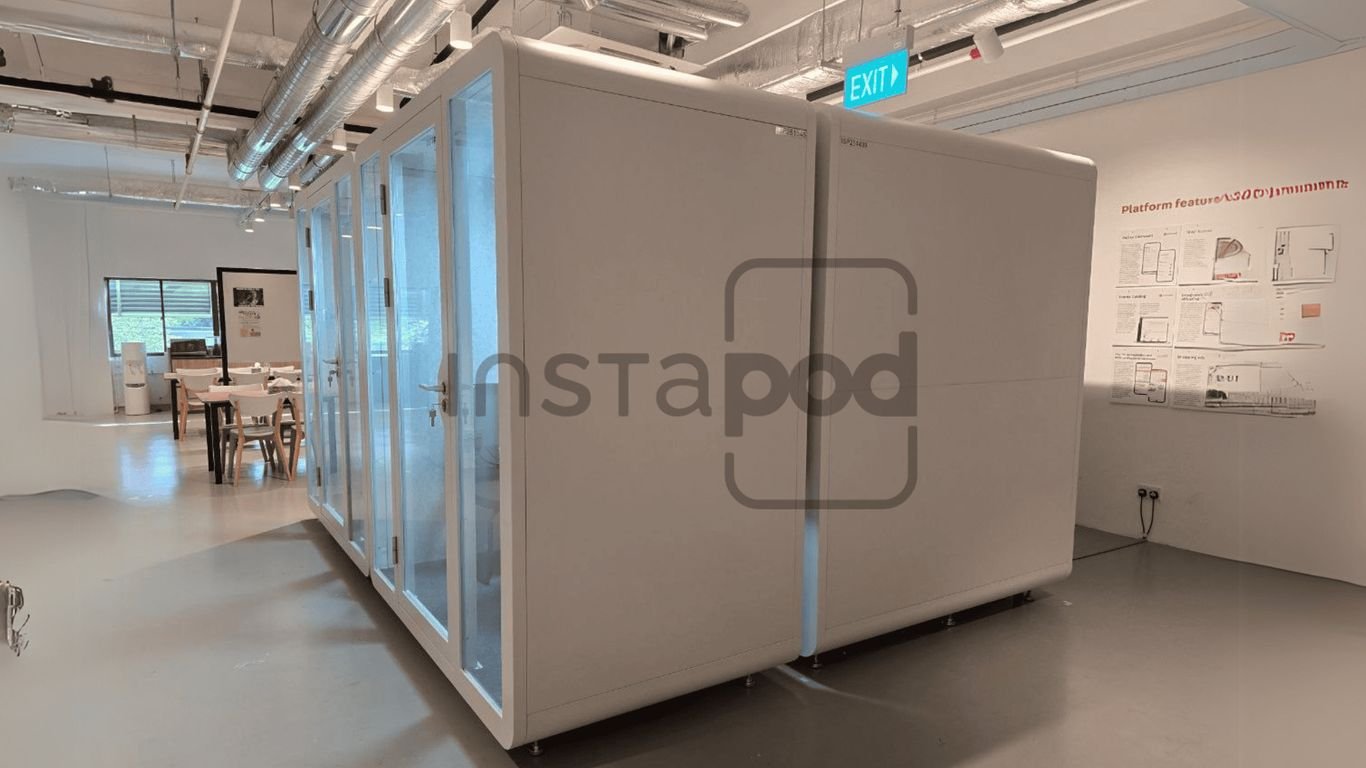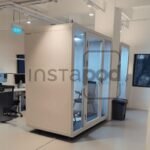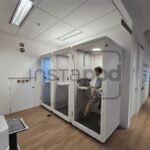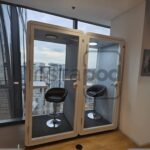No pods added to your quote request yet. Add some now for a free quote!
Picking out office pods for your team isn’t as simple as grabbing the first one you see. These days, offices are louder and busier than ever, so having a quiet spot to work or meet is a big deal. But with so many types of pods out there—some for calls, some for groups, some that move around—it’s easy to get lost. If you’re thinking about adding office pods to your space, you’ll want to make sure you’re getting the right ones for how your team actually works. Here’s what you need to know before you buy.
Key Takeaways
- Figure out how your team will use the office pods—solo work, calls, or group meetings—before making a choice.
- Check the size and style of pods to fit both your space and your team’s needs, not just what looks cool.
- Think about where to put the pods so people actually use them and they don’t block walkways or stick out awkwardly.
- Look for important features like soundproofing, good lighting, and easy access to power outlets.
- Pick a vendor with solid reviews and support, so you’re not stuck if something breaks or you need help later.
Understanding Different Types of Office Pods
Picking the right pod sounds simple, but when you actually look at all the options—trust me—it gets overwhelming fast. Pods meeting different needs are everywhere; you’ve got everything from tiny phone booths to full-on modular rooms. Let’s walk through the main types of office pods out there, whether you’re outfitting an open workspace, upgrading home offices or thinking about meeting pods Singapore-style.
Single-Person Focus Pods
These are like little sanctuaries you drop into a busy office.
- Perfect for solo deep work or back-to-back video calls—they block out distractions pretty well.
- Compact size means you can easily fit them into almost any corner.
- Usually come with just enough space for a chair and desk, but don’t expect much else.
If you’re constantly hunting for a private spot, even in an office pods for home setup, this is the way to go.
A well-placed focus pod can be the difference between a stressful day and actually ticking things off your to-do list.
Collaborative Meeting Pods
Need to bring folks together without the postage-stamp conference room vibe? Meeting pods are a solid fix.
- Sized for two to eight people, depending on the model.
- Often include whiteboards, screens, and charging points.
- Good for anything from team huddles to brainstorming—especially if you value thoughtful design boosts creativity.
| Pod Type | Common Capacity | Standard Features |
|---|---|---|
| Small Meeting Pod | 2-4 people | Seating, Table, Whiteboard |
| Large Meeting Pod | 6-8 people | Screens, Outlets, Video Capability |
Phone Booth-Style Pods
These are exactly what they sound like: compact, private places for calls.
- Just enough space to stand or sit and make a confidential call.
- Ideal for open-plan areas where every sound carries.
- Sometimes even used as a quick check-in spot for remote team conversations.
If you need quiet phone time without moving to another floor, go for a phone booth pod.
Modular and Flexible Pods
When your workspace is always changing—or you’re planning to grow—modular pods are your friend.
- Adjustable layouts: rearrange as your needs shift.
- Easy to move or expand (some come with wheels or simple-to-reconfigure panels).
- Ideal if you want to experiment instead of picking a permanent solution.
You can tweak modular meeting pods as your team changes, so you’re not locked into one style or size forever.
Each of these pods is designed to solve different workspace headaches, whether it’s getting away from noise, holding quick meetings, or planning for future changes.
So before you pick any type, think about what your team really needs. That’s how you’ll get pods that feel right for your space—not just ones that look good in a catalog.
Assessing Your Team’s Needs and Work Patterns
Figuring out which office pods actually help your team boils down to paying attention to what people do all day—how they work, where they get distracted, and why they might need a break from the open office.
Identifying Use Cases for Office Pods
Before shopping, make sure you know what problems you’re solving with office pods. It’s not just about filling up space so it looks modern. Pods are only useful if they meet specific needs. Here’s a quick rundown of common pod uses:
- Private video calls or confidential chats
- Group brainstorming sessions where whiteboards and privacy matter
- Hybrid work, like remote check-ins or team huddles
- A silent place for solo work during noisy office hours
- Personal needs (nursing, wellbeing)
When you lay this all out, you can justify your spending, and it’s easier to explain what you’re doing—and why.
If you aren’t sure how folks will use pods, start with a few and ask for feedback. Sometimes what people need isn’t what you first expect.
Sizing Pods for Individuals and Groups
Not every pod needs to be the size of a meeting room, and not everyone wants to cram into a phone booth when they need to focus. The key is offering a mix of sizes suited for how your team works. Here’s a sample table for thinking through your options:
| Use Case | Ideal Pod Size | Typical Occupants |
|---|---|---|
| Video calls/solo work | 1-person booth | 1 |
| Small team meetings | 2-4 person pod | 2-4 |
| Brainstorming/huddles | 4-6 person pod | 4-6 |
| Personal needs | Specialized pod | 1 |
Small pods are usually more flexible—teams can split up, while bigger pods are good for group chats or project bursts. Make sure you’re not guessing—ask people what’s actually going to get used.
Supporting Hybrid and Remote Work
Remote and hybrid setups mean you can have part of your team out of the office, calling in from kitchens or coffee shops. Meanwhile, folks in the office need places where they can join a call without distracting everyone around them. When you think about remote work, consider:
- Pods with built-in screens or good lighting for video meetings
- Access to reliable power and fast Wi-Fi connections
- Sound insulation so outside chatter doesn’t leak onto Zoom calls
- Space where people can talk at normal volume, not whisper
Having a thoughtful setup helps keep everyone connected whether they’re inside the building or calling in from home. Modern, well-placed office pods can support all these ways of working and reduce daily distractions.
Overall, matching pods to actual work patterns (instead of just guessing) saves money and improves how people feel about coming to work.
Evaluating Pod Placement and Integration into Your Office
Getting the right spot for your office pod can really change how your team uses it day to day. Pick the wrong place, and that pod might just become another piece of furniture no one touches.
Choosing Central or Private Locations
Where you put your pod depends on what you want from it:
- For quick phone calls or solo work, pods work best in quiet areas away from busy foot traffic.
- Collaborative meeting pods do well near open workspaces or where teams gather.
- Avoid spots next to loud equipment (like printers) since it kills focus and privacy.
- Make sure there’s space to open the door without bumping into other furniture.
Here’s a quick table to match pod type with placement:
| Pod Type | Ideal Placement |
|---|---|
| Single-Person Focus Pod | Distant from noisy areas |
| Meeting Pod | Near team or central spaces |
| Phone Booth | Near main pathways, but not too exposed |
The perfect pod placement isn’t always obvious on paper. Try asking a handful of team members where they’d want to see it. Sometimes, your "ideal spot" isn’t as useful as you imagined once people start using the pod.
Blending Pods with Office Design
It helps if your pod feels like a thoughtful part of the office, not just dropped into a random corner. Office pods come in so many designs, from simple and low-key to bold and colorful. If you’re looking to keep things consistent, try matching the materials or colors to what you already have in the office. Or, if you want the pod to stand out—maybe as a booking spot—pick something a bit different.
- Use adjustable furniture inside for different tasks or people
- Think about integrating branding or custom finishes
- Make sure the pod shade and lighting match what’s already in your space
You can read more about integrating pods for teamwork and creativity into your workspace design—ergonomics matter just as much as appearance.
Planning for Traffic Flow and Accessibility
Fruitful pod placement isn’t just about looks—it’s about daily movement:
- Keep walkways open, so people aren’t squeezed past the pod door.
- Consider if the pod will block visibility between teams or disrupt regular communication.
- Position pods close to power sources and ventilation if people will sit inside for long periods.
- Plan for future changes—pods that are modular or on wheels can be moved if your office layout shifts.
Here’s a short checklist for a smooth install:
- Can you get the pod through all doors and elevators?
- Are the main power and IT outlets within reach?
- Is it easy to find from the main workspace without being disruptive?
Thinking it through now saves you from having to redo things later. Office pods can really boost your team’s productivity, but only if people actually use them. The sweeter your setup, the more likely they are to step inside and get things done.
Key Features to Look for in Office Pods
Choosing office pods is more than just picking a color and a size. The features you settle on affect how well your team can work, how long the pod lasts, and whether everyone actually wants to use it. Here’s what to really pay attention to.
Soundproofing and Acoustic Control
Noise control is one of the biggest reasons people love office pods. Effective office pods use thick panels, acoustic foam, and sealed doors to block distractions from all sides. Watch for pods that list their sound isolation ratings (measured in decibels), especially if your office gets noisy or is open-plan.
| Pod Type | Soundproofing (dB reduction) | Typical Usage |
|---|---|---|
| Phone Booth | 30-35 | Calls, solo focus |
| Meeting Pod (4-person) | 25-30 | Team huddles |
| Modular Work Pod | 20-25 | Flexible work, short meetings |
Don’t settle for less—bad soundproofing wastes the whole investment.
When one pod lets outside voices leak in, it only takes one distracted worker to ruin the calm for everyone nearby.
Ventilation and Lighting Options
If there’s no air flow or the lighting is harsh, people simply won’t use the pod. Most quality pods have:
- Built-in, quiet fans or air vents
- Options for natural daylight (windows, skylights)
- Adjustable LED lighting for calls and focused work
Pods without these lead to headaches and poor focus. Always ask if you can adjust the airflow and brightness before making a decision.
Power and Technology Integration
Modern work calls for up-to-date tech in every space. Office pods aren’t just quiet—the best ones come wired for everything your devices might need. Look for:
- Multiple power outlets and USB ports
- Reliable internet connectivity (wired/Ethernet and WiFi pass-through)
- Extras like wireless charging or built-in screens for quick meetings
Pods with poor wiring or no cable management quickly get cluttered or even dangerous. For hybrid teams who hop between office and home, tech setup should work right out of the box. Many pods on the market, like those found in flexible, cost-effective office pods, are engineered this way to help your space keep up with changing needs.
A pod with solid lighting, air, and tech feels like a small office; a pod without them feels like a closet—guess which one gets used?
Quick Feature Checklist:
- High-grade acoustic materials (check decibel ratings)
- Comfortable and adjustable lighting systems
- Reliable air flow or climate control
- Plenty of power connections
- Solid networking support
When you get these features right, pods will feel less like an afterthought and more like mini work spaces people actually seek out.
You can find pods that fit all these needs, and some even allow for future upgrades. Take the time to compare different brands and read reviews, like those for office pods that boost productivity, so you can pick what’s really best for your entire team.
Balancing Privacy, Comfort, and Accessibility
The best office pods aren’t just about shutting out noise—they work when every person on your team can feel comfortable and included. There’s a lot more to these pods than sticking a box in the corner. You want spaces where people can focus, stay comfortable, and not have to worry if the physical space itself makes their day harder.
ADA-Compliant and Inclusive Designs
Making sure your pods are easy for everyone to use isn’t just a nice-to-have; it’s a must if you want your workplace to work for all. Here’s what good inclusivity looks like:
- Wide doorways and no steps, so wheelchair users have zero obstacles.
- Door handles or push plates that are easy to operate for employees with different abilities.
- Clear floor space for turning or using mobility aids (like 5’ diameter is a common standard).
- Low thresholds so no one trips or gets stuck on the way in.
- Visual and tactile indicators for accessibility where needed.
| Feature | ADA Compliance Requirement |
|---|---|
| Door Width | Minimum 32 inches |
| Floor Turning Space | 5 feet diameter |
| Threshold Height | 1/2 inch max, beveled |
| Controls & Handles | Operable with one hand, easy |
If you want everyone to feel welcome in the pod, start with the basics: clear entry and enough room to move around comfortably.
Ergonomic Furnishings for Comfort
Comfort isn’t just a cushion—it’s about supporting healthy posture and giving people options, especially for long meetings or concentrated work. Here’s what to look for in pod furnishings:
- Adjustable chairs to support any body type
- Desks and tables at standard (or adjustable) heights
- Footrests or flat, sturdy floors for stability
- Soft seating for lounge-style pods
You’ll be surprised how fast people start to avoid a pod if the seat wobbles or the table digs into their knees.
Security and Confidentiality Enhancements
Pods should also help protect private conversations with good locks, sound isolation, and visual barriers. Think about these when picking the pod:
- Reliable door locks for confidential calls or private meetings
- Internal soundproofing so discussions don’t leak outside
- Option for frosted glass or solid walls to shield from outside view
- Personal lighting and privacy controls in each pod
It’s worth checking the actual sound reduction spec—noise should stay inside so nobody’s eavesdropping, especially in busy offices or areas prone to distractions. Pods offer cost-effective noise reduction and can help the whole team focus better if chosen carefully.
Separating these needs in your checklist means you won’t miss something key. From opening the door to sitting down and closing out your meeting, the right office pod makes privacy, comfort, and access feel effortless for all.
Considering Style, Branding, and Customization
When you’re adding office pods to your space, they shouldn’t feel tacked on or accidental. Every choice you make about style, color, and finish matters for how people feel and work. It’s not just about creating a quiet spot; it’s about making something that feels right for your team and fits what your business stands for.
Aligning Pods with Office Aesthetics
It’s strange how even small, modular pods can completely shift the vibe of a whole office. Start by asking yourself:
- Does the pod design match your current layout, or does it stand out in a bad way?
- Are you going for a super modern look or something more classic?
- Will the pod blend with your furniture, or clash?
The best approach is to treat office pods like any other big furniture piece. Think about shape, surface materials, glass vs. opaque panels, and overall color palette. Some businesses lean toward open, transparent pods. Others want solid colors and more privacy.
Color, Material, and Finish Options
There are tons of choices here, and getting it right isn’t always easy. Here’s a simple table to lay out common options:
| Element | Choices | Usual Uses |
|---|---|---|
| Color | Neutral, Bold, Custom | Match brand or create zones |
| Material | Wood, Metal, Glass, Felt | Aesthetics, acoustics, durability |
| Finish | Matte, Gloss, Texture | Mood-setting, easy cleaning |
If the goal is brand energy, a splash of your main color makes the pods pop. Want a calming spot? Stick with soft, muted tones. And don’t forget that fabric, metal, and glass all have their pros and cons, from cleaning to noise reduction. For more perspective, modular pods can be adjusted for size, color, and materials to really fit your space and workflow.
Branding Opportunities for Office Pods
Branded pods bring a sense of belonging—and quietly reinforce your identity. Some ideas:
- Custom vinyl graphics or decals with your logo or slogan
- Color-matched finishes that echo your website or product packaging
- Unique furniture or lighting that ties into your specific style
Small details count. Even branded door handles or printed acoustic panels can turn a plain pod into a statement piece. It shows visitors you care about the details, and it helps staff feel that they’re truly part of the company.
Pods aren’t just functional—they’re a chance to make your culture visible in everyday spaces, which motivates people more than you might think.
Don’t be afraid to ask pod makers about custom options, or request samples. A little tweaking can make the difference between a pod people avoid and one they actually look forward to using.
Choosing the Right Vendor and Support Services
When you reach the point of picking a vendor for your office pods, a lot more goes into it than just price tags or glossy marketing images. Who you buy from will impact how those pods serve your team in the long run. It can honestly be the difference between pods that blend in perfectly at work or ones that collect dust in a corner because set up was a mess.
Evaluating Product Quality and Reviews
Start by finding out how pods from each vendor really hold up at work, not just in warehouse photos. Look out for these details:
- Read multiple customer reviews—especially those from companies similar to yours.
- Ask for case studies or referrals, if possible.
- Check for certifications or awards that prove the pods meet safety and quality standards (like ISO ratings).
Trust builds when you see real feedback, and you don’t want to be the test subject for a company that just started selling pods last week. Exploring modular, flexible units for modern offices can be a smart way to learn about durability and user experience firsthand.
Warranty and After-Sales Support
Warranties tell you how confident a maker is in their own product. But they’re not all the same.
| Vendor | Standard Warranty | On-Site Repairs | Spare Parts Policy |
|---|---|---|---|
| Vendor A | 1 year | Yes | Ships in 3-5 days |
| Vendor B | 5 years | No | Customer-purchased |
| Vendor C | 3 years | Yes | Free replacements |
When you’re reading the fine print, look for:
- What’s actually covered (full replacement, repairs, and for how long)
- If labor, transport, or custom parts are included or extra
- How easy it is to get someone on the phone when a problem comes up
A solid warranty and seller that sticks around help you avoid future headaches.
Delivery, Installation, and Maintenance
A vendor’s responsibility shouldn’t stop at dropping something off at your loading dock. These details really matter:
- Will they assemble the pods, or is that on you?
- Do they offer floor plan consultations?
- How fast can pods get repaired or replaced?
Here’s a list of what a good support process should look like:
- Simple, reliable scheduling for delivery and installation
- Clear training or handover for your facilities team
- Ongoing help for maintenance—think of things like cleaning guides, spare parts, or hotline advice
Many businesses say the true value of office pods comes not just from the features, but the help you get before and after purchase.
To sum up, vendors aren’t just selling you pods—they’re offering a small service contract that lasts as long as you own those units. Check reviews, ask questions, and remember: assessing vendor support will set you up for a smoother experience in the long run.
Wrapping Up: Finding the Right Office Pod for Your Team
Choosing the right office pod isn’t rocket science, but it does take a bit of thought. Every team works a little differently, and what feels perfect for one group might not work at all for another. Start by figuring out what your team actually needs—whether it’s a quiet spot for calls, a place to brainstorm, or just somewhere to escape the office noise for a bit. Don’t forget to measure your space and think about where the pod will go, so you don’t end up with something that blocks the hallway or sits unused in a corner. Ask your team for feedback, too—they’re the ones who’ll be using it every day. At the end of the day, the best office pod is the one that fits your workflow and makes the workday a little smoother. Take your time, do a bit of research, and you’ll end up with a setup that everyone appreciates.
Frequently Asked Questions
What is an office pod and why would my team need one?
An office pod is a small, private space you can put inside your office. It helps people focus, make phone calls, or have quiet meetings without being disturbed by noise. Teams use them to get work done in peace, especially in busy or open-plan offices.
How do I know which size office pod is right for my team?
Start by thinking about how many people will use the pod at once and what they’ll use it for. If it’s just for calls or solo work, a small single-person pod is fine. For group chats or meetings, pick a bigger pod that fits everyone comfortably.
Where should I put an office pod in my office?
Place the pod somewhere easy to reach but not in the way. Good spots are near common areas but away from noisy equipment like printers. Make sure there’s enough space to open the door and move around it easily.
Are office pods soundproof?
Most office pods have special walls to block out noise, but how quiet they are depends on the model. Some are almost completely silent inside, while others just make things quieter. Check the pod’s sound rating before you buy.
Can office pods be moved if we rearrange our office?
Some office pods are built to be moved, while others are heavier and meant to stay put. If you think you’ll change your office layout often, look for a pod that’s easy to move or has wheels.
What features should I look for in an office pod?
Look for things like good lighting, ventilation, power outlets, and comfortable seating. If you need privacy, check for lockable doors or extra soundproofing. Also, make sure the pod is easy to use for everyone, including people with disabilities.




